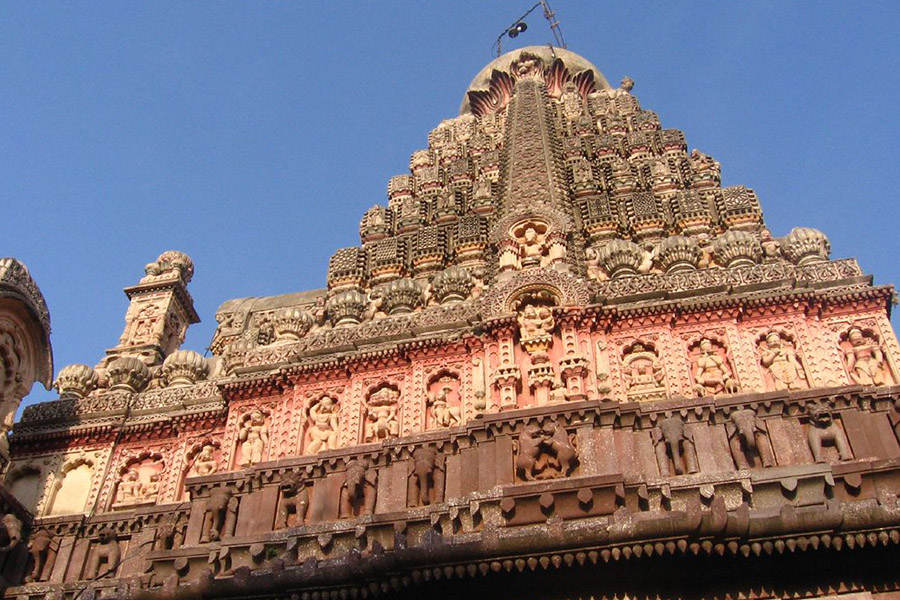Grishneswar Jyotirlinga Temple: A Divine Abode of Lord Shiva
Introduction
Grishneswar Jyotirlinga Temple, also known as the Ghushmeshwar Temple, is an ancient Hindu shrine dedicated to Lord Shiva. Located in the village of Ellora in the Indian state of Maharashtra, this temple holds immense religious significance and architectural beauty. It is one of the 12 Jyotirlingas, which are considered the holiest abodes of Lord Shiva and hold great importance in Hindu mythology.
Historical Background
The history of the Grishneswar Jyotirlinga Temple dates back to ancient times. According to legend, this sacred place was originally known as Kusumeshwar, named after a Brahmin named Kusuma. The temple is said to have been built by Rani Ahalyabai Holkar, a prominent queen of the Malwa kingdom, in the 18th century. The exquisite architecture and spiritual aura of the temple attract millions of devotees and tourists each year.
The Divine Architecture
The Grishneswar Jyotirlinga Temple is a fine example of medieval South Indian temple architecture. The temple complex features a grand entrance adorned with intricate carvings and sculptures. The main shrine dedicated to Lord Shiva houses the Jyotirlinga, which is the focal point of devotion for pilgrims. The temple’s architecture showcases a blend of Maratha and Rajput styles, and its walls depict scenes from ancient Hindu epics, such as the Mahabharata and Ramayana.
Legends and Myths
The temple is associated with several fascinating legends. One popular myth recounts the story of the demon Ghushmaasura, who was blessed with a boon that made him invincible. Drunk with power, he started tormenting the world and the gods. To counter this menace, Lord Shiva took the form of a Jyotirlinga and vanquished the demon, giving the temple its name, Grishneswar (meaning the ‘Lord of Compassion’).
Spiritual Significance
Grishneswar Jyotirlinga Temple holds immense spiritual significance for devotees of Lord Shiva. It is believed that offering prayers and performing rituals at this sacred site can cleanse one’s soul and wash away sins. Pilgrims come from all over the country to seek the blessings of Lord Shiva and attain spiritual enlightenment. The serene ambiance of the temple complex provides a perfect setting for meditation and self-reflection.
Festivals and Celebrations
The temple comes alive during various festivals celebrated with great enthusiasm. Mahashivaratri, the Great Night of Shiva, is one of the most important festivals observed here. Devotees throng the temple premises, singing hymns and offering special prayers to Lord Shiva. The annual Bhramotsavam (chariot festival) is another grand event when the deity is taken out in a beautifully adorned chariot, and the air is filled with joyous chants and devotional fervor.
How to Reach
Grishneswar Jyotirlinga Temple is well-connected by road, and visitors can reach the temple by hiring local transport or taxis from Aurangabad, which is the nearest major city. The temple is located approximately 30 kilometers from Aurangabad and can be reached in about an hour’s drive.
Preserving Heritage and Legacy
Efforts have been made to preserve the architectural heritage and sanctity of the Grishneswar Jyotirlinga Temple. The Archaeological Survey of India (ASI) and various other organizations have taken initiatives to conserve the temple’s historical and artistic significance, ensuring that future generations can continue to witness the divine charm of this holy abode.
Conclusion
The Grishneswar Jyotirlinga Temple stands as a testimony to the rich cultural and religious heritage of India. With its intricate architecture and spiritual ambiance, it continues to be a beacon of divinity, drawing devotees and tourists alike. A visit to this sacred site is a soul-stirring experience, allowing one to connect with the divine and embrace the eternal essence of Lord Shiva.
FAQs
- Is photography allowed inside the temple? Photography is allowed in certain areas of the temple, but it is advisable to seek permission from the temple authorities before capturing any photographs.
- Are there any accommodation options near the temple? Yes, there are several accommodation options available near the temple, ranging from budget hotels to luxurious resorts.
- Can non-Hindus visit the Grishneswar Jyotirlinga Temple? Yes, the temple is open to people of all religions and beliefs. Visitors are expected to respect the sanctity of the place and follow the temple’s rules and customs.
- What are the temple timings? The temple is open for darshan from early morning till late evening. The exact timings may vary on special occasions and festivals.
- Are there any nearby tourist attractions worth visiting? Yes, the Ellora Caves, a UNESCO World Heritage Site, are located close to the Grishneswar Jyotirlinga Temple and are a must-visit for history and architecture enthusiasts.



